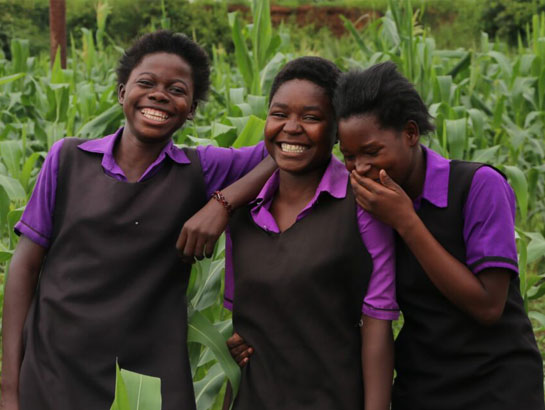In Zambia, the learning and earning potential of 40% of children under five has been stunted by chronic undernutrition.
While feeding schoolchildren has always been a key part of the government’s nutrition strategy, sometimes funding constraints leave a gap between aspirations and reality. HarvestPlus saw a way to fill that gap in a nutritious and educational way.
“A lot of schools have available arable land,” says Acanda Ubomba-Jaswa, HarvestPlus’ market development manager in Africa. “Enabling schools to grow maize allows for a sustainable way for them to feed themselves.”
HarvestPlus is now exploring opportunities to integrate vitamin A maize into school feeding programs. Last year, the Ministry of Education and HarvestPlus launched a competition that would show children the benefits of adding color to their health.
“Schools have become an entry point for us because we are targeting mothers and children,” explains country manager Eliab Simpungwe. “We believe if children can become familiar with orange maize and they can demand it—like it—then the families, the mothers will provide this food.”
Maize provides around 30% of the total calories of more than 4.5 billion people in developing countries and is the most widely eaten staple food in Africa. HarvestPlus’ nutrition studies have indicated that orange maize can improve the vitamin A status of populations. Half of Zambia’s children are deficient in vitamin A, leaving them vulnerable to measles or diarrhea; if not halted in time, this will lead to blindness or death.
“Our farmers know what type of variety of maize to ensure that our children will come to school, will be the future leaders of our country,” says Joseph Kamana, district commissioner, Kafue Department of Agriculture.
Students at four primary schools in the region selected by the district commissioner grew a hectare of vitamin A maize. While they cared for their crops, teachers used existing vitamin A maize cobs and posters to help the students learn about the nutritional benefits of the project. Once the maize was reaped, a cooking demonstration allowed students and their parents to taste their hard work.
While all the students came away with new school supplies and a new awareness of vitamin A’s role in keeping them health, one school received a special reward for the success of their harvest. For their 48,880 maize cobs harvested, the Chipapa Primary School earned a hammer mill to grind maize for income and student consumption.

“We want to influence diet choices starting at a young age, so that children not only make good choices for themselves, but also take that knowledge home to their parents and influence decisions in the household,” says Simpungwe.
